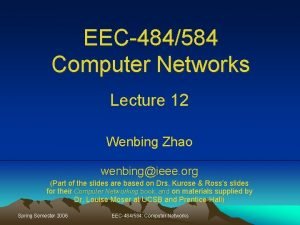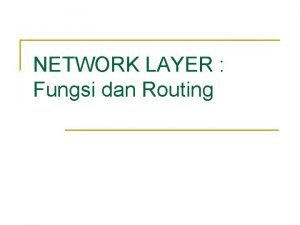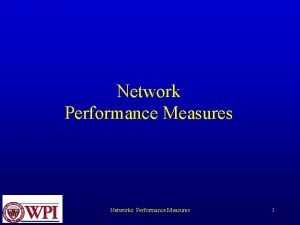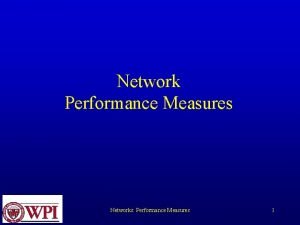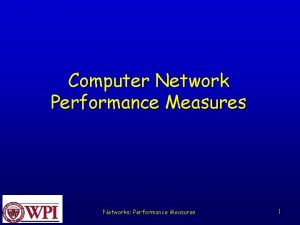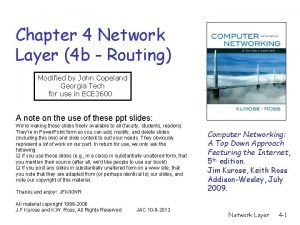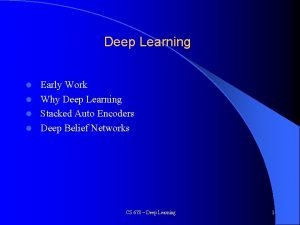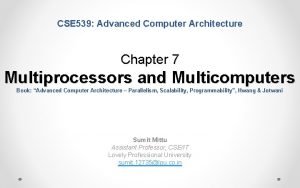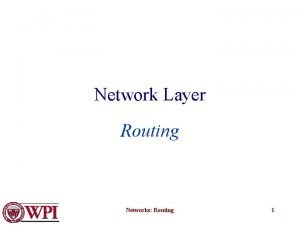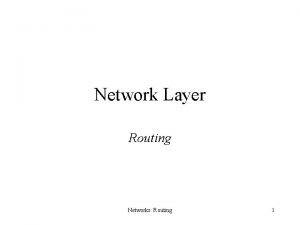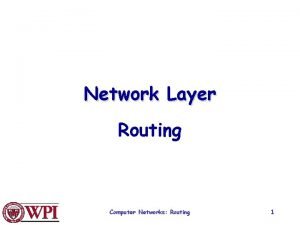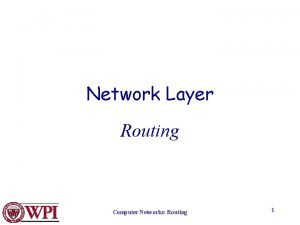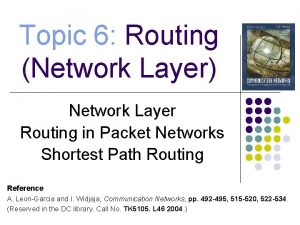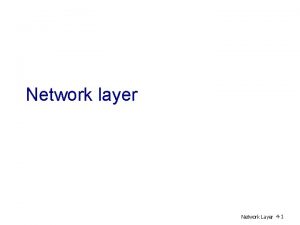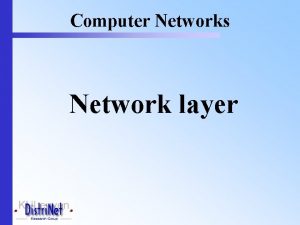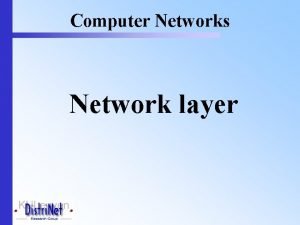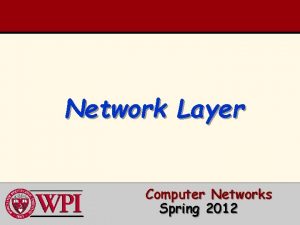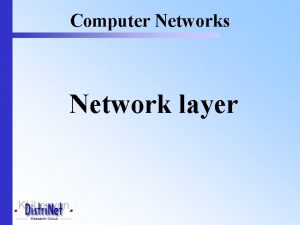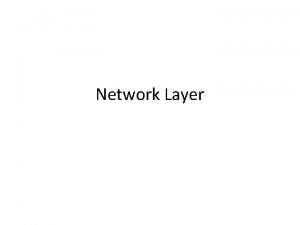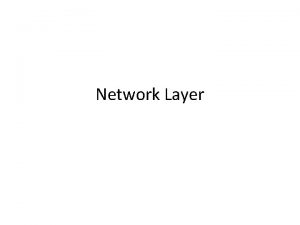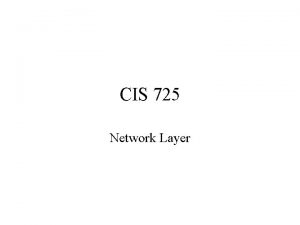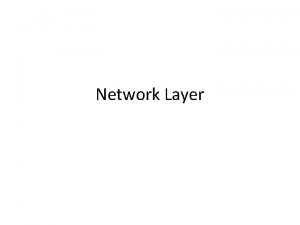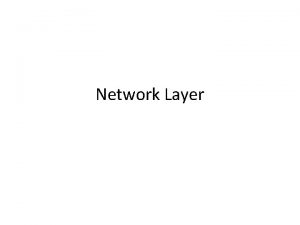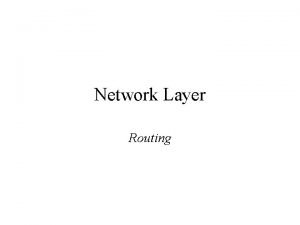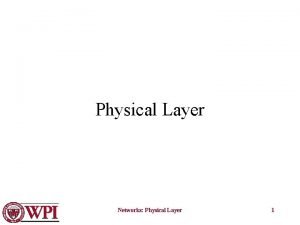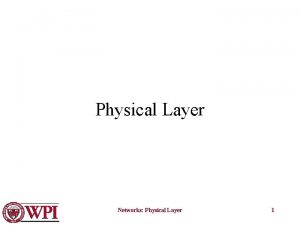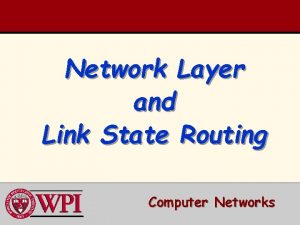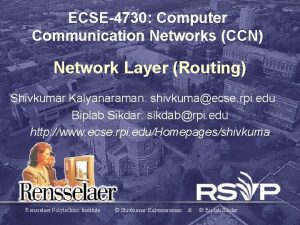Network Layer Routing Computer Networks Routing 1 Network















![Shortest Path Routing 1. Bellman-Ford Algorithm [Distance Vector] 2. Dijkstra’s Algorithm [Link State] What Shortest Path Routing 1. Bellman-Ford Algorithm [Distance Vector] 2. Dijkstra’s Algorithm [Link State] What](https://slidetodoc.com/presentation_image/296af50e8a36e1405ddeabc5d8b1319a/image-16.jpg)




![Internetwork Routing [Halsall] Adaptive Routing Centralized [RCC] Distributed [IGP] Intradomain routing Interior Gateway Protocols Internetwork Routing [Halsall] Adaptive Routing Centralized [RCC] Distributed [IGP] Intradomain routing Interior Gateway Protocols](https://slidetodoc.com/presentation_image/296af50e8a36e1405ddeabc5d8b1319a/image-21.jpg)





![Distance Vector Algorithm [Perlman] 1. A router transmits distance vector to each of its Distance Vector Algorithm [Perlman] 1. A router transmits distance vector to each of its](https://slidetodoc.com/presentation_image/296af50e8a36e1405ddeabc5d8b1319a/image-27.jpg)











![OSPF LSA Types Router link advertisement [Hello message] Network link advertisement Network summary link OSPF LSA Types Router link advertisement [Hello message] Network link advertisement Network summary link](https://slidetodoc.com/presentation_image/296af50e8a36e1405ddeabc5d8b1319a/image-39.jpg)

![OSPF Areas [AS Border router] To another AS R 1 N 2 R 2 OSPF Areas [AS Border router] To another AS R 1 N 2 R 2](https://slidetodoc.com/presentation_image/296af50e8a36e1405ddeabc5d8b1319a/image-41.jpg)


- Slides: 43

Network Layer Routing Computer Networks: Routing 1

Network Layer • Concerned with getting packets from source to destination. • The network layer must know the topology of the subnet and choose appropriate paths through it. • When source and destination are in different networks, the network layer (IP) must deal with these differences. * Key issue: what service does the network layer provide to the transport layer (connectionoriented or connectionless). Computer Networks: Routing 2

Network Layer Design Goals 1. The services provided by the network layer should be independent of the subnet topology. 2. The Transport Layer should be shielded from the number, type and topology of the subnets present. 3. The network addresses available to the Transport Layer should use a uniform numbering plan (even across LANs and WANs). Computer Networks: Routing 3

Messages Segments Transport layer Network service Network layer End system Data link layer a Data link layer Data link End system layer b Physical layer Network layer Copyright © 2000 The Mc. Graw Hill Companies Leon-Garcia & Widjaja: Communication Networks Computer Networks: Routing Figure 7. 2 4

Machine A Machine B Application Transport Router/Gateway Internet Network Interface Network 1 Transport Network 2 Computer Networks: Routing 5 Figure 8. 3

Metropolitan Area Network (MAN) Gateway Organization Servers To internet or wide area network s s Backbone R R R S Departmental Server R S S R R s s s s s Copyright © 2000 The Mc. Graw Hill Companies Leon-Garcia & Widjaja: Communication Networks Computer Networks: Routing Figure 7. 6 6

Wide Area Network (WAN) Interdomain level Border routers Autonomous system or domain Border routers Internet service provider LAN level Copyright © 2000 The Mc. Graw Hill Companies Intradomain level Leon-Garcia & Widjaja: Communication Networks Computer Networks: Routing Figure 7. 7 7

National service provider A (a) National ISPs National service provider B NAP National service provider C Network Access Point (b) NAP RA RB Route server LAN RC Copyright © 2000 The Mc. Graw Hill Companies Computer Networks: Routing Leon-Garcia & Widjaja: Communication Networks 8 Figure 7. 8

Packet 1 Packet 2 Copyright © 2000 The Mc. Graw Hill Companies Leon-Garcia & Widjaja: Communication Networks Computer Networks: Routing Figure 7. 15 9

Destination address Output port 0785 7 1345 12 1566 6 2458 12 Copyright © 2000 The Mc. Graw Hill Companies Leon-Garcia & Widjaja: Communication Networks Computer Networks: Routing Figure 7. 16 10

Packet Copyright © 2000 The Mc. Graw Hill Companies Leon-Garcia & Widjaja: Communication Networks Computer Networks: Routing Figure 7. 17 11

Identifier Output port Next identifier 12 13 44 15 15 23 27 13 16 58 7 34 Entry for packets with identifier 15 Copyright © 2000 The Mc. Graw Hill Companies Leon-Garcia & Widjaja: Communication Networks Computer Networks: Routing Figure 7. 21 12

Routing algorithm: : that part of the Network Layer responsible for deciding on which output line to transmit an incoming packet. Remember: For virtual circuit subnets the routing decision is made ONLY at set up. Algorithm properties: : correctness, simplicity, robustness, stability, fairness, optimality, and scalability. Computer Networks: Routing 13

Routing Classification Adaptive Routing Non-Adaptive Routing • • 1. 2. 3. based on current measurements of traffic and/or topology. centralized isolated distributed 1. routing computed in advance and off-line flooding 2. static routing using shortest path algorithms Computer Networks: Routing 14

Flooding • Pure flooding : : every incoming packet to a node is sent out on every outgoing line. – Obvious adjustment – do not send out on arriving link (assuming full-duplex links). – The routing algorithm can use a hop counter (e. g. , TTL) to dampen the flooding. – Selective flooding : : only send on those lines going “approximately” in the right direction. Computer Networks: Routing 15
![Shortest Path Routing 1 BellmanFord Algorithm Distance Vector 2 Dijkstras Algorithm Link State What Shortest Path Routing 1. Bellman-Ford Algorithm [Distance Vector] 2. Dijkstra’s Algorithm [Link State] What](https://slidetodoc.com/presentation_image/296af50e8a36e1405ddeabc5d8b1319a/image-16.jpg)
Shortest Path Routing 1. Bellman-Ford Algorithm [Distance Vector] 2. Dijkstra’s Algorithm [Link State] What does it mean to be the shortest (or optimal) route? Choices: a. Minimize the number of hops along the path. b. Minimize mean packet delay. c. Maximize the network throughput. Computer Networks: Routing 16

Possible Metrics • Set all link costs to 1. – Shortest hop routing. – Disregards delay and capacity differences on links! • {Original ARPANET} Measure the number of packets queued to be transmitted on each link. – Did not work well. Computer Networks: Routing 17

Metrics {Second ARPANET} • Timestamp each arriving packet with its Arrival. Time and record Depart. Time* and use link-level ACK to compute: Delay = (Depart. Time – Arrival. Time) + Transmission. Time + Latency • The weight assigned to each link was average delay over ‘recent’ packets sent. • This algorithm tended to oscillate – leading to idle periods and instability. * Reset after retransmission Computer Networks: Routing 18

Metrics {Revised ARPANET} – Compress dynamic range of the metric to account for link type – Smooth the variation of metric with time: • • • Delay transformed into link utilization Utilization was then averaged with last reported utilization to deal with spikes. Set a hard limit on how much the metric could change per measurement cycle. Computer Networks: Routing 19

Dijkstra’s Shortest Path Algorithm Initially mark all nodes (except source) with infinite distance. working node = source node Sink node = destination node While the working node is not equal to the sink 1. Mark the working node as permanent. 2. Examine all adjacent nodes in turn If the sum of label on working node plus distance from working node to adjacent node is less than current labeled distance on the adjacent node, this implies a shorter path. Relabel the distance on the adjacent node and label it with the node from which the probe was made. 3. Examine all tentative nodes (not just adjacent nodes) and mark the node with the smallest labeled value as permanent. This node becomes the new working node. Reconstruct the path backwards from sink to source. Computer Networks: Routing 20
![Internetwork Routing Halsall Adaptive Routing Centralized RCC Distributed IGP Intradomain routing Interior Gateway Protocols Internetwork Routing [Halsall] Adaptive Routing Centralized [RCC] Distributed [IGP] Intradomain routing Interior Gateway Protocols](https://slidetodoc.com/presentation_image/296af50e8a36e1405ddeabc5d8b1319a/image-21.jpg)
Internetwork Routing [Halsall] Adaptive Routing Centralized [RCC] Distributed [IGP] Intradomain routing Interior Gateway Protocols Distance Vector routing [RIP] Isolated Interdomain routing [EGP] Exterior [BGP, IDRP] Gateway Protocols Link State routing [OSPF, IS-IS, PNNI] Computer Networks: Routing 21

Adaptive Routing Design Issues: 1. How much overhead is incurred due to gathering the routing information and sending routing packets? 2. What is the time frame (i. e, the frequency) for sending routing packets in support of adaptive routing? 3. What is the complexity of the routing strategy? Computer Networks: Routing 22

Adaptive Routing Basic functions: 1. Measurement of pertinent network data. 2. Forwarding of information to where the routing computation will be done. 3. Compute the routing tables. 4. Convert the routing table information into a routing decision and then dispatch the data packet. Computer Networks: Routing 23

Centralized Routing RCC

Distance Vector Routing • Historically known as the old ARPANET routing algorithm {or known as Bellman-Ford algorithm}. Basic idea: each network node maintains a Distance Vector table containing the distance between itself and ALL possible destination nodes. • Distances are based on a chosen metric and are computed using information from the neighbors’ distance vectors. Metric: usually hops or delay Computer Networks: Routing 25

Distance Vector Routing Information kept by DV router 1. each router has an ID 2. associated with each link connected to a router, there is a link cost (static or dynamic). Distance Vector Table Initialization Distance to itself = 0 Distance to ALL other routers = infinity number Computer Networks: Routing 26
![Distance Vector Algorithm Perlman 1 A router transmits distance vector to each of its Distance Vector Algorithm [Perlman] 1. A router transmits distance vector to each of its](https://slidetodoc.com/presentation_image/296af50e8a36e1405ddeabc5d8b1319a/image-27.jpg)
Distance Vector Algorithm [Perlman] 1. A router transmits distance vector to each of its neighbors in a routing packet. 2. Each router receives and saves the most recently received distance vector from each of its neighbors. 3. A router recalculates its distance vector when: It receives a distance vector from a neighbor containing different information than before. b. It discovers that a link to a neighbor has gone down (i. e. , a topology change). a. The DV calculation is based on minimizing the cost to each destination. Computer Networks: Routing 27

Distance Vector Routing Figure 5 -9. (a) A subnet. (b) Input from A, I, H, K, and the new routing table for J. Computer Networks: Routing 28

Routing Information Protocol (RIP) • RIP had widespread use because it was distributed with BSD Unix in “routed”, a router management daemon. • RIP is the most used Distance Vector protocol. • RFC 1058 in June 1988. • Sends packets every 30 seconds or faster. • Runs over UDP. • Metric = hop count • BIG problem is max. hop count =16 RIP limited to running on small networks!! • Upgraded to RIPv 2 Computer Networks: Routing 29

(network_address, distance) pairs Figure 4. 17 RIP Packet Format P&D slide Computer Networks: Routing 30

Link State Algorithm 1. Each router is responsible for meeting its neighbors and learning their names. 2. Each router constructs a link state packet (LSP) which consists of a list of names and cost to reach of its neighbors. 3. The LSP is transmitted to ALL other routers. Each router stores the most recently generated LSP from each other router. 4. Each router uses complete information on the network topology to compute the shortest path route to each destination node. Computer Networks: Routing 31

Figure 4. 18 Reliable LSP Flooding P&D slide Computer Networks: Routing 32

Reliable Flooding • The process of making sure all the nodes participating in the routing protocol get a copy of the link-state information from all the other nodes. • LSP contains: – Sending router’s node ID – List of connected neighbors with the associated link cost to each neighbor – Sequence number – Time-to-live (TTL) Computer Networks: Routing 33

Reliable Flooding • • First two items enable route calculation Last two items make process reliable – ACKs and checking for duplicates is needed. • • Periodic Hello packets used to determine the demise of a neighbor. The sequence numbers are not expected to wrap around. – this field needs to be large (64 bits) Computer Networks: Routing 34

Open Shortest Path First (OSPF) • Provides for authentication of routing messages. – 8 -byte password designed to avoid misconfiguration. • Provides additional hierarchy – Domains are partitioned into areas. – This reduces the amount of information transmitted in packet. • Provides load-balancing via multiple routes. Computer Networks: Routing 35

Open Shortest Path First (OSPF) Backbone area Figure 4. 32 A Domain divided into Areas P&D slide Computer Networks: Routing 36

Open Shortest Path First (OSPF) • OSPF runs on top of IP, i. e. , an OSPF packet is transmitted with IP data packet header. • Uses Level 1 and Level 2 routers • Has: backbone routers, area border routers, and AS boundary routers • LSPs referred to as LSAs (Link State Advertisements) • Complex algorithm due to five distinct LSA types. Computer Networks: Routing 37

OSPF Terminology Internal router : : a level 1 router. Backbone router : : a level 2 router. Area border router (ABR) : : a backbone router that attaches to more than one area. AS border router : : (an interdomain router), namely, a router that attaches to routers from other ASs across AS boundaries. Computer Networks: Routing 38
![OSPF LSA Types Router link advertisement Hello message Network link advertisement Network summary link OSPF LSA Types Router link advertisement [Hello message] Network link advertisement Network summary link](https://slidetodoc.com/presentation_image/296af50e8a36e1405ddeabc5d8b1319a/image-39.jpg)
OSPF LSA Types Router link advertisement [Hello message] Network link advertisement Network summary link advertisement AS border router’s summary link advertisement 5. AS external link advertisement 1. 2. 3. 4. Computer Networks: Routing 39

Indicates LSA type Indicates link cost Figure 4. 21 OSF Type 1 Link-State Advertisement P&D slide Computer Networks: Routing 40
![OSPF Areas AS Border router To another AS R 1 N 2 R 2 OSPF Areas [AS Border router] To another AS R 1 N 2 R 2](https://slidetodoc.com/presentation_image/296af50e8a36e1405ddeabc5d8b1319a/image-41.jpg)
OSPF Areas [AS Border router] To another AS R 1 N 2 R 2 N 5 R 3 R 6 R 4 R 5 N 4 R 7 N 6 N 3 Area 0. 0. 0. 1 R 8 Area 0. 0 N 7 Area 0. 0. 0. 3 Copyright © 2000 The Mc. Graw Hill Companies Leon-Garcia & Widjaja: Communication Networks Computer Networks: Routing Area 0. 0. 0. 2 ABR R = router N = network Figure 8. 33 41

OSPF Figure 5 -65. The relation between ASes, backbones, and areas in OSPF. Tanenbaum slide Computer Networks: Routing 42

Border Gateway Protocol (BGP) • The replacement for EGP is BGP. Current version is BGP-4. • BGP assumes the Internet is an arbitrary interconnected set of AS’s. • In interdomain routing the goal is to find ANY path to the intended destination that is loop-free. The protocols are more concerned with reachability than optimality. Computer Networks: Routing 43
 Network layer is concerned with
Network layer is concerned with Design issues of network layer
Design issues of network layer Algorithms in computer networks
Algorithms in computer networks Broadcast routing in computer networks
Broadcast routing in computer networks Difference between datagram and virtual circuit network
Difference between datagram and virtual circuit network Basestore iptv
Basestore iptv Switching in data link layer
Switching in data link layer Osi model in computer networks
Osi model in computer networks Elementary data link protocols
Elementary data link protocols Hdlc and ppp
Hdlc and ppp Fungsi network layer
Fungsi network layer Principles of network applications
Principles of network applications Network performance measurement in computer networks
Network performance measurement in computer networks Network performance measurement in computer networks
Network performance measurement in computer networks Router node
Router node Graphical method of flood routing
Graphical method of flood routing Mark tinka
Mark tinka Hydrologic continuity equation
Hydrologic continuity equation Power routing in vlsi
Power routing in vlsi Inter vlan routing layer 3 switch
Inter vlan routing layer 3 switch Arg
Arg Layer 4 routing
Layer 4 routing A link layer protocol for quantum networks
A link layer protocol for quantum networks Greedy layer wise training of deep networks
Greedy layer wise training of deep networks Fig 19
Fig 19 Pathway of food from mouth to anus
Pathway of food from mouth to anus Secure socket layer and transport layer security
Secure socket layer and transport layer security Layer 6 presentation layer
Layer 6 presentation layer Secure socket layer and transport layer security
Secure socket layer and transport layer security Secure socket layer and transport layer security
Secure socket layer and transport layer security Secure socket layer and transport layer security
Secure socket layer and transport layer security Layer 2 e layer 3
Layer 2 e layer 3 Layer-by-layer assembly
Layer-by-layer assembly Layer 2 vs layer 3 bitstream
Layer 2 vs layer 3 bitstream Topology in computer
Topology in computer Message routing schemes in computer architecture
Message routing schemes in computer architecture Crc in computer networks
Crc in computer networks Crc in computer networks
Crc in computer networks Traffic management in computer networks
Traffic management in computer networks Speed of a computer
Speed of a computer What is optimality principle in computer networks
What is optimality principle in computer networks Snmp ports
Snmp ports What is optimality principle in computer networks
What is optimality principle in computer networks Business application of computer network
Business application of computer network



